2016 Peugeot 308 spare wheel
[x] Cancel search: spare wheelPage 212 of 344
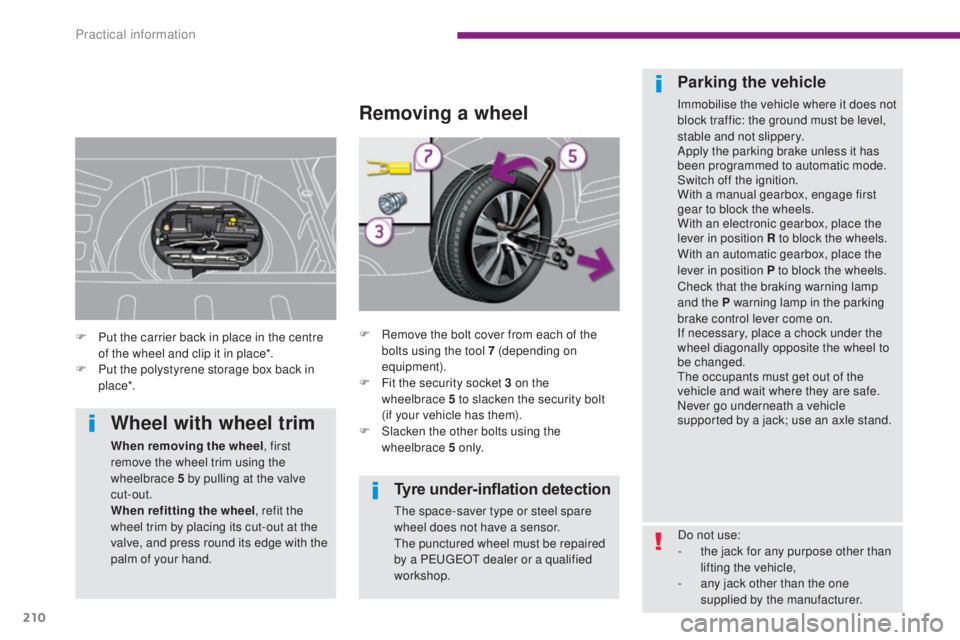
210
3008_en_Chap10_infos-pratiques_ed01-2015
Tyre under-inflation detection
The space-saver type or steel spare
wheel does not have a sensor.
The punctured wheel must be repaired
by a PEUGEOT dealer or a qualified
workshop.
Removing a wheel
F Remove the bolt cover from each of the bolts using the tool 7 (depending on
equipment).
F
F
it the security socket 3 on the
wheelbrace
5 to slacken the security bolt
(if
your vehicle has them).
F
S
lacken the other bolts using the
wheelbrace 5 o n l y.
Parking the vehicle
Immobilise the vehicle where it does not
block traffic: the ground must be level,
stable and not slippery.
Apply the parking brake unless it has
been programmed to automatic mode.
Switch off the ignition.
With a manual gearbox, engage first
gear to block the wheels.
With an electronic gearbox, place the
lever in position R to block the wheels.
With an automatic gearbox, place the
lever in position P to block the wheels.
Check that the braking warning lamp
and the P warning lamp in the parking
brake control lever come on.
If necessary, place a chock under the
wheel diagonally opposite the wheel to
be changed.
The occupants must get out of the
vehicle and wait where they are safe.
Never go underneath a vehicle
supported by a jack; use an axle stand.
F
P
ut the carrier back in place in the centre
of the wheel and clip it in place*.
F
P
ut the polystyrene storage box back in
p lac e*.
Wheel with wheel trim
When removing the wheel , first
remove the wheel trim using the
wheelbrace 5 by pulling at the valve
cut-out.
When refitting the wheel , refit the
wheel trim by placing its cut-out at the
valve, and press round its edge with the
palm of your hand. Do not use:
-
t
he jack for any purpose other than
lifting the vehicle,
-
a
ny jack other than the one
supplied by the manufacturer.
Practical information
Page 213 of 344
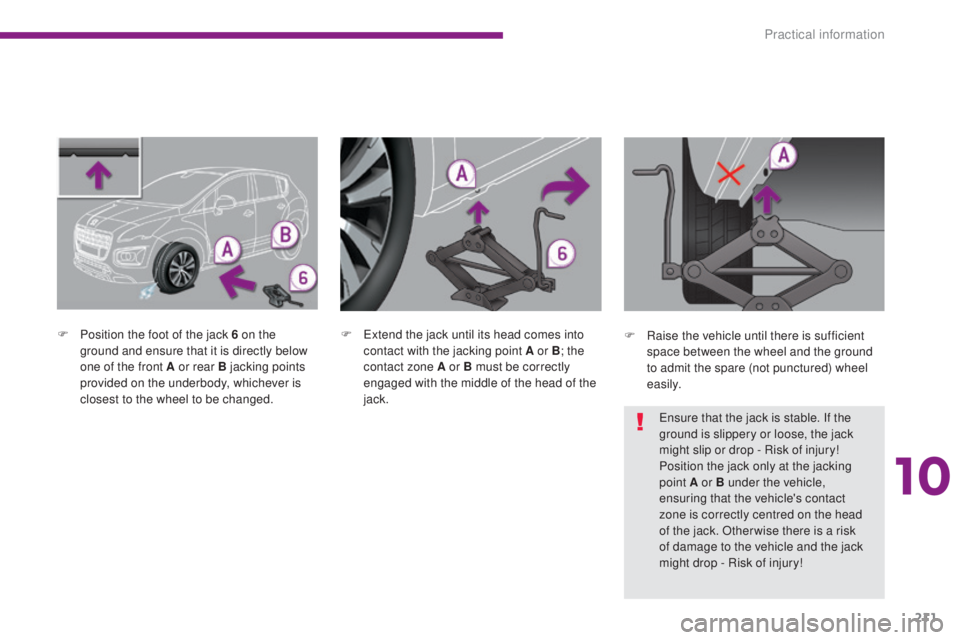
211
3008_en_Chap10_infos-pratiques_ed01-2015
F Position the foot of the jack 6 on the ground and ensure that it is directly below
one of the front A or rear B jacking points
provided on the underbody, whichever is
closest to the wheel to be changed. F
E xtend the jack until its head comes into
contact with the jacking point A or B ; the
contact zone A or B must be correctly
engaged with the middle of the head of the
jack. F
Ra ise the vehicle until there is sufficient
space between the wheel and the ground
to admit the spare (not punctured) wheel
easily.
Ensure that the jack is stable. If the
ground is slippery or loose, the jack
might slip or drop - Risk of injury!
Position the jack only at the jacking
point A or B under the vehicle,
ensuring that the vehicle's contact
zone is correctly centred on the head
of the jack. Otherwise there is a risk
of damage to the vehicle and the jack
might drop - Risk of injury!
10
Practical information
Page 214 of 344
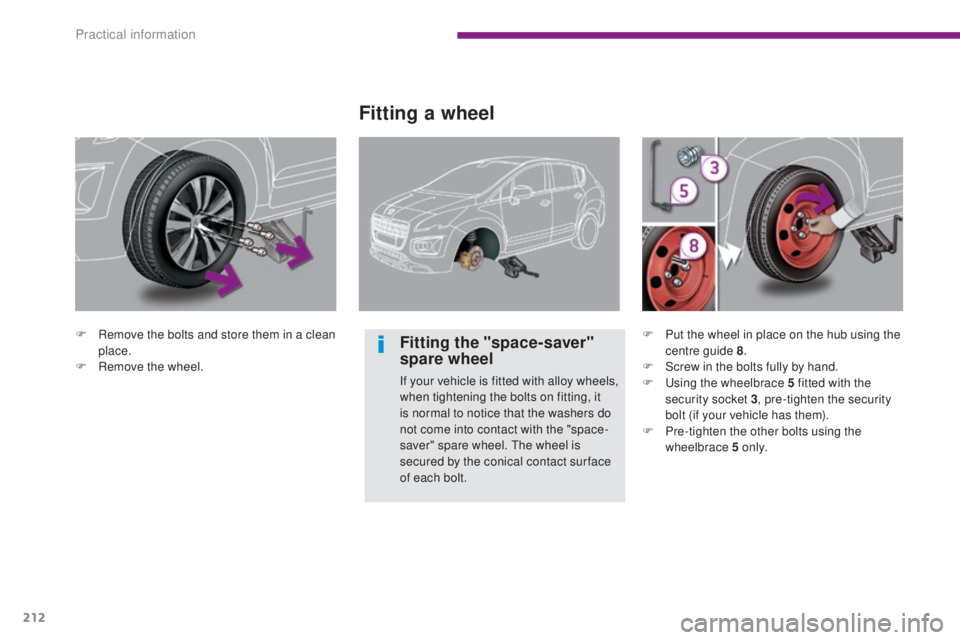
212
3008_en_Chap10_infos-pratiques_ed01-2015
F Remove the bolts and store them in a clean place.
F
R
emove the wheel.
Fitting a wheel
Fitting the "space-saver"
spare wheel
If your vehicle is fitted with alloy wheels,
when tightening the bolts on fitting, it
is normal to notice that the washers do
not come into contact with the "space-
saver" spare wheel. The wheel is
secured by the conical contact sur face
of each bolt. F
P
ut the wheel in place on the hub using the
centre guide 8 .
F S crew in the bolts fully by hand.
F U sing the wheelbrace 5 fitted with the
security socket 3 , pre-tighten the security
bolt (if your vehicle has them).
F
P
re-tighten the other bolts using the
wheelbrace 5 o n l y.
Practical information
Page 215 of 344
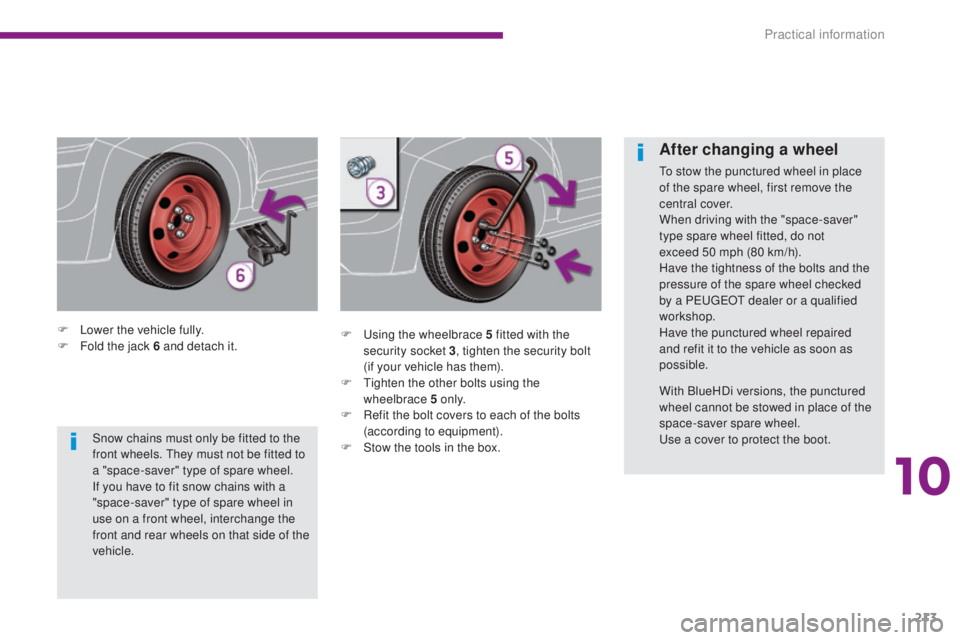
213
3008_en_Chap10_infos-pratiques_ed01-2015
F Lower the vehicle fully.
F F old the jack 6 and detach it. F
U sing the wheelbrace 5 fitted with the
security socket 3 , tighten the security bolt
(if your vehicle has them).
F
T
ighten the other bolts using the
wheelbrace 5 o n l y.
F
R
efit the bolt covers to each of the bolts
(according to equipment).
F
S
tow the tools in the box.
After changing a wheel
To stow the punctured wheel in place
of the spare wheel, first remove the
central cover.
When driving with the "space-saver"
type spare wheel fitted, do not
exceed 50 mph (80 km/h).
Have the tightness of the bolts and the
pressure of the spare wheel checked
by a PEUGEOT dealer or a qualified
workshop.
Have the punctured wheel repaired
and refit it to the vehicle as soon as
possible.
With BlueHDi versions, the punctured
wheel cannot be stowed in place of the
space-saver spare wheel.
Use a cover to protect the boot.
Snow chains must only be fitted to the
front wheels. They must not be fitted to
a "space-saver" type of spare wheel.
If you have to fit snow chains with a
"space-saver" type of spare wheel in
use on a front wheel, interchange the
front and rear wheels on that side of the
vehicle.
10
Practical information
Page 216 of 344
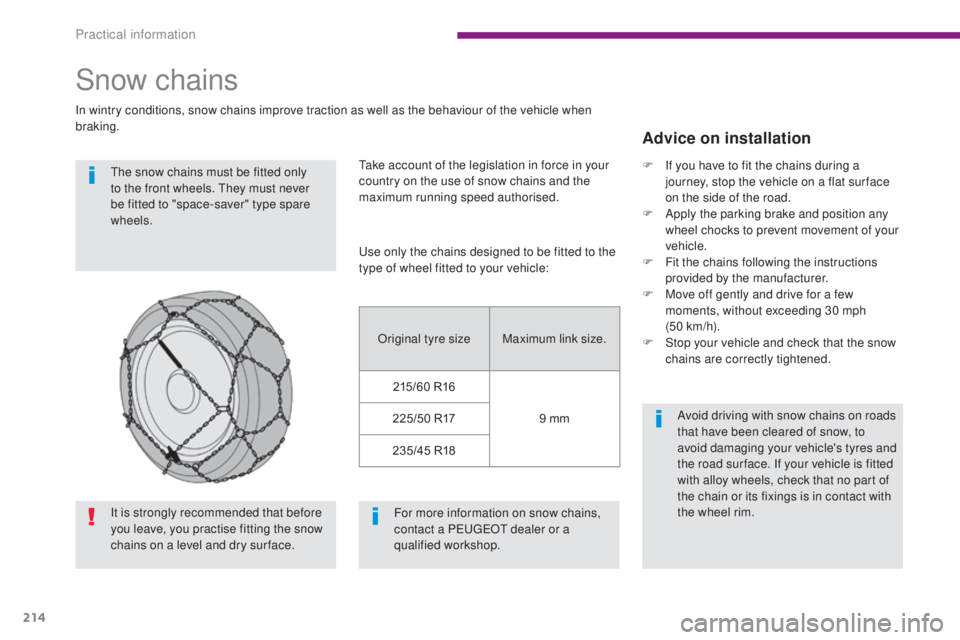
214
3008_en_Chap10_infos-pratiques_ed01-2015
Snow chains
In wintry conditions, snow chains improve traction as well as the behaviour of the vehicle when
braking.The snow chains must be fitted only
to the front wheels. They must never
be fitted to "space-saver" type spare
wheels. Take account of the legislation in force in your
country on the use of snow chains and the
maximum running speed authorised.
Advice on installation
Avoid driving with snow chains on roads
that have been cleared of snow, to
avoid damaging your vehicle's tyres and
the road sur face. If your vehicle is fitted
with alloy wheels, check that no part of
the chain or its fixings is in contact with
the wheel rim.
For more information on snow chains,
contact a PEUGEOT dealer or a
qualified workshop.
Use only the chains designed to be fitted to the
type of wheel fitted to your vehicle:
Original tyre size Maximum link size.
215/60 R16 9 mm
225/50 R17
235/45 R18 F
I
f you have to fit the chains during a
journey, stop the vehicle on a flat sur face
on the side of the road.
F
A
pply the parking brake and position any
wheel chocks to prevent movement of your
vehicle.
F
F
it the chains following the instructions
provided by the manufacturer.
F
M
ove off gently and drive for a few
moments, without exceeding 30 mph
(50
km/h).
F
S
top your vehicle and check that the snow
chains are correctly tightened.
It is strongly recommended that before
you leave, you practise fitting the snow
chains on a level and dry sur face.
Practical information
Page 253 of 344
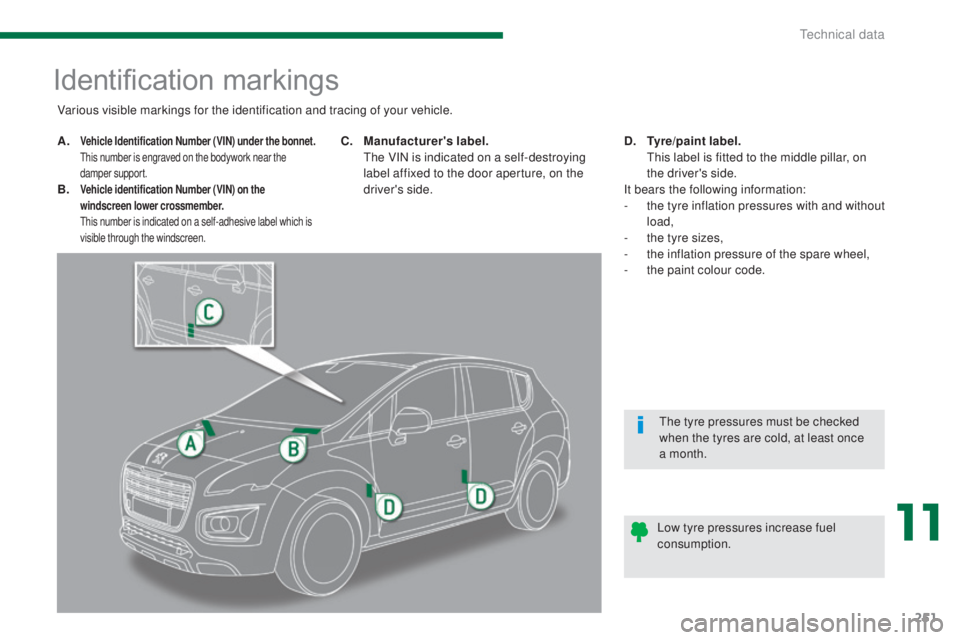
251
3008_en_Chap11_caracteristiques_ed01-2015
Identification markings
A. Vehicle Identification Number (VIN) under the bonnet. T
his number is engraved on the bodywork near the
damper support.
B. Vehicle identification Number (VIN) on the windscreen lower crossmember.
T
his number is indicated on a self-adhesive label which is
visible through the windscreen.
C. Manufacturer's label. T
he VIN is indicated on a self-destroying
label affixed to the door aperture, on the
driver's side. D. T
yre/paint label.
T
his label is fitted to the middle pillar, on
the driver's side.
It bears the following information:
-
t
he tyre inflation pressures with and without
load,
-
t
he tyre sizes,
-
t
he inflation pressure of the spare wheel,
-
t
he paint colour code.
Various visible markings for the identification and tracing of your vehicle.
Low tyre pressures increase fuel
consumption.The tyre pressures must be checked
when the tyres are cold, at least once
a month.
11
Technical data
Page 338 of 344
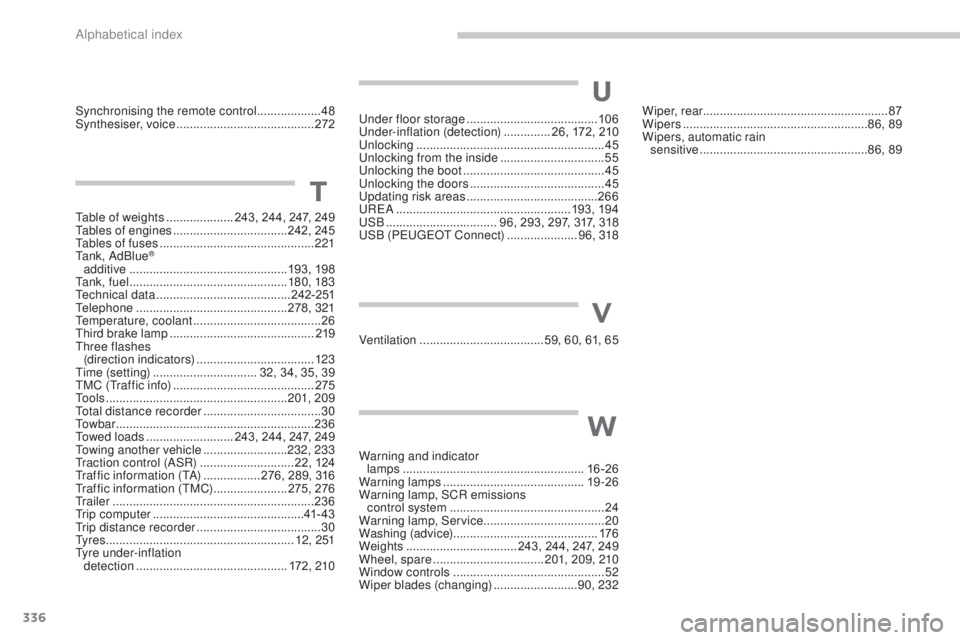
336
3008_en_Chap13_index-alpha_ed01-2015
Synchronising the remote control ...................48
Synthesiser, voice ......................................... 2
72
Table of weights
....................24
3, 244 , 247, 249
Tables of engines
.................................. 242, 245
Tables of fuses
.............................................. 221
Tank, AdBlue
®
additive
............................................... 193, 198
Ta n k , f u e l
............................................... 180, 183
Technical data
........................................ 242- 2 51
Telephone
............................................. 278, 321
Temperature, coolant
...................................... 26
Third brake lamp
........................................... 219
Three flashes (direction indicators)
................................... 123
Time (setting)
..............................
.32 , 34 , 35, 39
TMC (Traffic info)
.......................................... 2
75
To o l s
...................................................... 201, 209
Total distance recorder
................................... 30
To w b a r
........................................................... 236
Towed loads
.......................... 243, 244 , 247, 249
Towing another vehicle
......................... 2
32, 233
Traction control (ASR)
............................ 22, 124
Traffic information (TA)
................. 276, 289 , 316
Traffic information (TMC)
...................... 2
75, 276
Tr a i l e r
............................................................ 236
Trip computer
............................................. 41- 4 3
Trip distance recorder
..................................... 30
Ty r e s
........................................................ 12 , 2 51
Tyre under-inflation detection
............................................. 172, 210
U
T
Under floor storage ....................................... 10 6
Under-inflation (detection) .............. 2
6, 172, 210
Unlocking
..............................
..........................45
Unlocking from the inside
...............................55
U
nlocking the boot .......................................... 45
Unlocking the doors
........................................ 45
Updating risk areas
....................................... 26
6
UREA
.................................................... 193, 19 4
USB
................................. 96, 293, 297, 317, 318
USB ( P
E
UGEOT
C
onnect)
.....................96,
318Wiper, rear
....................................................... 87
Wipers .......................................................86, 89
Wipers, automatic rain sensitive
..................................................86, 89
Ventilation
..............................
.......59, 60, 61, 65
V
Warning and indicator
lamps .............................. ........................16 -26
Warning lamps
.......................................... 19-26
Warning lamp, SCR emissions control system
.............................................. 24
W
arning lamp, Service .................................... 20
Washing (advice) ........................................... 176
Weights
................................. 243, 244 , 247, 249
Wheel, spare
................................. 201, 209 , 210
Window controls
............................................. 52
Wiper blades (changing)
......................... 90,
232
W
Alphabetical index